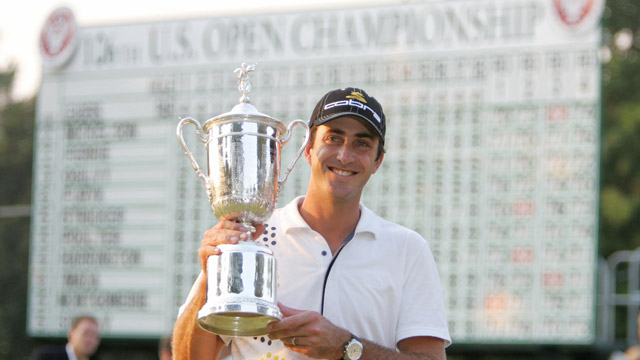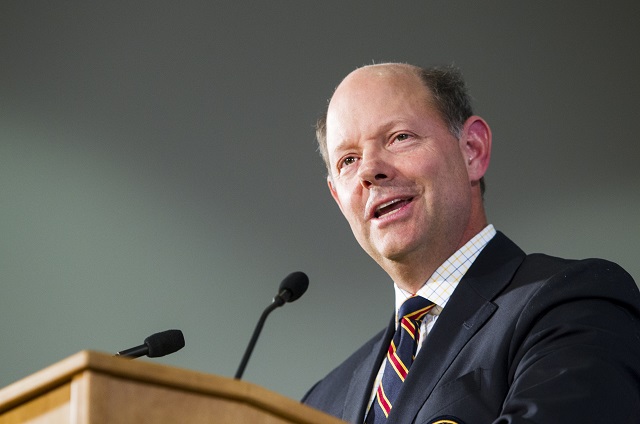Thoughts of Oakmont’s U.S. Open ‘horror chamber’ is sending shivers into the greats of the game but not lone Scot Russell Knox.
Defending champion, Jordan Spieth describes Oakmont as ‘scary’ while Phil Mickelson, and who’s been runner-up no less than six-times, says the course to the toughest he’ll ever face.
It’s not that Oakmont is the only U.S. Open venue not to have any water hazards that will please Knox after his Sawgrass water ‘torture’ or the fact that it is one of the shortest to host golf’s second-oldest Major.
And it’s nothing to do with the fact the 2016 U.S. Open is to be only the second at Oakmont to be played without trees.
No, Oakmont is tough. Toughest of the tough!
Knox has competed in just one U.S. Open and that was in 2013 at Merion but then the Merion that witnessed Justin Rose winning at one over par wil nothing compared to the course facing Knox and his fellow competitors.
Knox said: “All that I have heard about Oakmont is horror stories and how tough it is going to be.
“But I love it when it’s super-hard because I feel like for much of the time when it’s like that, I make less mistakes than most and I am able to scrape it around and get it up-and-down.
“So despite what everyone who has been up to Oakmont in recent weeks is saying that is what playing in the Majors is all about as you will play venues that can be really tough and others not so tough.
“Though when I look back when I was growing up in Inverness the one Major I thought that would suit my game the best would be the U.S. Open.
“That’s because I feel as though I drive the ball well but then for the most part Majors are the hardest tournaments and so they should be and they tend to favour the guys that smash it.
“So hopefully this U.S. Open will fit my game perfectly though I’ve played in five now but only made the cut in one, so it’s not like I am knocking on the door.
“I finished 45th in my first one so the next step is playing in them regularly and start competing but then my game overall is in good shape.”
Back in 2007, Mickelson clung to the cut-off line till very late on Friday afternoon, and until Angel Cabrera put his second shot at the last to two feet and holed the birdie putt.
Cabrera’s birdie not only knocked out Mickelson but another 18 players, and was then asked about knocking Mickelson out of Oakmont.
He said: I did not knock out Mickelson, Mickelson knocked out himself. He shot 11-under par”.
Tiger Woods went into that same 2007 U.S. Open as the then Open Champion and PGA Championship title-holder.
He’d won both the 2006 Open at Royal Liverpool and the PGA later that year at Medinah with 14-under par victory totals.
Woods would walk off Oakmont in 2007 shooting six over and lose by a shot to Cabrera.
He said: “The U.S. Open is not an easy championship. It’s probably the most difficult championship that we face all year, because you’re tested from tee-to-green and you’re tested on the greens.
“Generally if you’re missing one facet of your game, more than likely you’re not going to win the championship. You have to have everything going.
“And looking back on Oakmont it’s hard, really hard.
“When you think back they softened the golf course up for us that last day and 5-over par as a winning score, so that shows you how difficult this golf course really is”.
The course opened 103-years ago in 1913 and is the oldest still on the U.S. Open rota. It’s also the only course the USGA, that plays host to the championship hasn’t had to ‘Tiger-proof.
But then as 7,200 yards, and by today’s standards, it’s one of shortest on the list of U.S. Open host venues.
However, when it comes to U.S. Open venues Oakmont is right up there with the brutes of host venues such as Winged Foot where the average winning score in hosting five U.S. Open’s is 3.2 over par.
The last time Winged Foot hosted a U.S. Open in 2006 Aussie Geoff Ogilvy won at five over par and that was a year before Cabrera won with the same tally.
You would have to go back to the 1974 U.S. Open at Winged Foot where Hale Irwin won at seven over to find a U.S. Open venue as Oakmont in 2007 and Winged Foot in 2006.
It’s something that Knox knows he’s going to have to get his head around, and when you consider also he won the WGC – HSBC Champions late last year with a 20-under par total.
He said: “Normally, the tournaments I play in where the winning score is around par or just over par you know they are brutal and you’re going to be in for a tough four days as they are so hard.
“It’s also somewhat strange because once you get used to shooting under par it is such a different mind-set compared to being four or five over as you can be still well in the tournament.
“It takes really mentally strong players to win tournaments like a U.S. Open when the winning score if something like three, four or five over par.
“But then I am getting there and while I am probably not there yet, I have got loads of time.”
Knox will find Oakmont unique also in design and features.
While there’s no water hazards on Oakmont there’s just two dog-leg holes, the 4th and 17th, and there’s a famed bunker named the ‘Church Pews’ that come into play at three and four.
They measure about 100 by 40 yards and features twelve grass covered traversing ridges that resemble church pews.
And USGA Executive Director, Mike Davis, who has overseen the set-up of the last 27 U.S. Open venues says those teeing-up later this week at Oakmont should be saying their prayers as it will much of the ‘sameness’ as those who competing in 2007.
He said: “Anyone wondering how this year’s Open here compares to the last time it was here can expect a lot of sameness.
“Every hole is exactly the same yardage as it was in 2007. The same fairway widths and contours as we played in 2007. The same fairway widths and contours the members here at Oakmont have been playing for years and years.”
“They’re the same grass heights and rough from 2007. The same green speeds as 2007. The same general hole locations as 2007. Same bunkering and the same wonderful course conditioning.
“But it’s going to be all the challenge you want.”
OAKMONT – U.S. OPEN HISTORY
1922 – Tommy Armour (Scotland) – Wins in play-off after 5-over total. Average score 78.6 (or 6.6 over par)
1935 – Sam Parks Jnr (USA) – Wins by 2 shots with 11-over par. Average score 80.55 (or 8.55 over par)
1953 – Ben Hogan (USA) – Wins by 6 shots with 5-under par. Average score 77.12 (or 5.12 over par)
1962 – Jack Nicklaus (USA) – Wins in play-off over Arnold Palmer after tied at 1 under. Average score 75.86 (4.86 over par)
1973 – Johnnie Miller (USA) – Comes from six shots back to win by one shot after shooting final round 63 for 5 under par tally. Average score 75.45 (or 4.45 over par)
1983 – Larry Nelson (USA) wins by a shot at 4 under par. Average score 75.13 (or 4.13 over par)
1994 – Ernie Els (South Africa) beats Colin Montgomerie and Loren Roberts in a play-off after each ending at five under. Average score 74.25 (or 3.45 over par)
2007 – Angel Cabrera (Argentina) wins by a shot at five over par. Average score 75.52 (or 5.72 over par)







